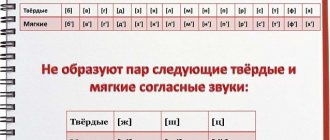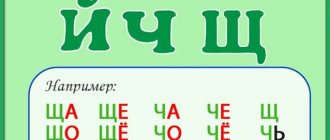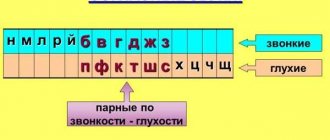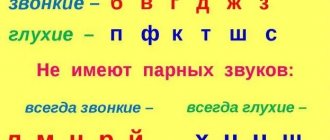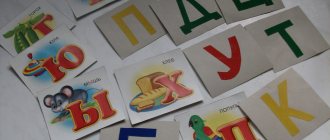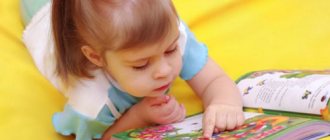Lesson 8. Vowels of the first and second row-2
"Ball Game"
1) An adult says, for example, “a” and throws the ball to the child, he responds by calling the corresponding letter of the second row (“i”) and throws the ball back. Below are materials for working with vowels of the first and second row.
2) An adult says a word (the list of words is given below) and throws the ball to the child. The child names the vowels from this word and throws the ball back.
3) Children paint the vowels in the words below in red; the consonant letter before the vowels a o u e y is in blue. The consonant letter before the vowels i ё yu e and is green.
Program 2. Course of lessons for children aged 5-10 years __________________ 431
| fish | needle | ear | watermelon | eyes | accordion |
| board | iris | ear | bag | clown | meat |
| window | rest | wasps | rumba | hoopoe | lives |
| wing | shoes | mustache | circles | pattern | flock |
| key | backpack | chandelier | skirt | chair | nests |
| eclair | feather | screen | huntsman | lotto | pit |
| hare | bees | elephant | cross | stomach | stars |
Lesson 9. Consonants M-N “Ball Game”
1) The presenter invites the children to substitute the sounds “mm” and “n-n” for the vowels of the first and second row. For example, an adult says “ma” and throws a ball to a child, and he answers “me” and throws the ball back. Below are materials for working with the sounds “mmm”, “n-nn”.
| ma mo mu me we me me me mu me me | na but well ne we nya no nude no | ma mo mu me we na but well ne we | me me mu me mi nya no nude no no |
2) An adult throws a ball and says a word (the list of words is given below). The child catches the ball, names the sound that is in this word (“mmm” or “n-nn”), and throws the ball back.
3) The child writes the missing consonants “m-n” into words in blue or green (indicating the hardness or softness of the consonants in the letter).
432 Part III. Didactic materials
Lesson 10. Consonants R-L “Ball Game”
1) See lesson 9, task 1.
2) See lesson 9, task 2.
3) See lesson 9, task 3.
-*T-
Lesson 11. Consonant And
"Ball Game"
1) An adult throws a ball and says a word (the list of words is given below). If the word contains the sound “and”, then the child catches the ball, if not, then he hits it.
2) The child finds the letter “i” in the words and paints it green (indicates a soft consonant sound).
Program 2. Course of lessons for children 5-10 years old __________________ 433
Lesson 12. Consonants B—P > “Ball Game”
1) See lesson 9, task 1.
2) See lesson 9, task 2.
3) See lesson 9, task 3.
Lesson 13. Consonants V—F “Ball game”
1) See lesson 9, task 1.
2) See lesson 9, task 2.
3) See lesson 9, task 3.
434 Part III. Didactic materials
Lesson 14. Consonants K-G “Ball game”
1) See lesson 9, task 1.
2) See lesson 9, task 2.
3) See lesson 9, task 3.
Lesson 15. Consonants D—T “Ball game”
1) See lesson 9, task 1.
2) See lesson 9, task 2.
3) See lesson 9, task 3.
Program 2. Course of lessons for children 5-10 years old____________________ 435
Lesson 16. Consonants 3—C “Ball Game”
1) See lesson 9, task 1.
2) See lesson 9, task 2.
3) See lesson 9, task 3.
Lesson 17. Consonants Ж—Ш
"Ball Game"
On the board, instead of the vowels of the first and second row, syllables with the consonants “zh-sh” are written (in accordance with the school curriculum).
1) See lesson 9, task 1.
2) An adult throws a ball and says a word (the list of words is given below). The child calls the sound (“zh-sh”) and throws the ball back.
3) See lesson 9, task 3.
436 Part III. Didactic materials
Lesson 18. Consonant “Ch”
"Ball Game"
On the board, instead of the vowels of the first and second row, syllables with the consonant “ch” are written (in accordance with the school curriculum).
1) The child pronounces the syllables (cha cho che chu che chi) simultaneously with the movement of his hands (see lesson 1, game “Semaphore”).
2) An adult throws a ball and says a word (the list of words is given below). If the word has the sound “ch”, then the child catches the ball, if not, then he hits it.
3) The child finds the letter “ch” and paints it green (indicates a soft consonant sound).
Lesson 19. Consonant “sch”
"Ball Game"
On the board, instead of the vowels of the first and second row, syllables with the consonant “u” are written (in accordance with the school curriculum).
Program 2. Course of lessons for children 5-10 years old____________________ 437
1) The child pronounces the syllables (sha shchu shchu shchi) simultaneously with the movement of his hands (see lesson 1, game “Semaphore”).
2) An adult throws a ball and says a word (the list of words is given below). If the word contains the sound “u”, then the child catches the ball, if not, then he hits it back.
3) The child finds the letter “ш” and paints it green (indicates a soft consonant sound).
Lesson 20. Consonant “C”
"Ball Game"
Syllables with the consonant “ts” are written on the board (in accordance with the school curriculum).
1) See lesson 19, task 1.
2) See lesson 19, task 2.
3) Find the letter “ts” and color it blue (indicates a hard consonant sound).
438 Part III. Didactic materials
Section 15. MEMORY _______________________________ 5-6 years
Lesson 1
“Find the same-1.” A child with his eyes closed feels a row of three surfaces (objects) of different textures. Then he selects objects or surfaces of the same texture from the proposed set and builds the proposed sequence.
Lesson 2
“Find the same-2.”
The exercise is carried out in the same way as in lesson 1, with the number of objects increasing to 4-5 and the children working in pairs.
Lesson 3
“Find the same-3.”
It is carried out in the same way as in lesson 2, but one more variable is added - objects differ not only in texture, but also in weight.
"Sculptor-1". A child standing or sitting with his eyes closed is given a certain position, then it is “removed”. The child’s task is to feel and remember it, and then reproduce it.
Lesson 4
"Sculptor-2". A child standing or sitting with his eyes closed is given a certain position, then it is “removed”. The child’s task is to feel and remember it, and then pass it on to another child.
"Freeze." The psychologist shows some pose. Then the children run around the hall and, on command, take the shown pose.
Lesson 5
“Sculptor-2” (see lesson 4).
"Motor memory". The psychologist sets a certain sequence of different movements. The children's task is to remember this sequence and reproduce it as accurately as possible.
Lesson 6
“Motor memory” (see lesson 5).
Program 2. Course of lessons for children aged 5-10 years __________________ 439
"Get things in order-1." A child with his eyes closed feels a number of surfaces (objects) of different textures. Then the psychologist changes several objects in a row. The child feels the row a second time and returns the objects to their places.
Lesson 7
"Get things in order-2." It is carried out in the same way as in the previous lesson, but now the objects differ not only in texture, but also in weight.
“Motor memory” (see lesson 6).
Lesson 8
"Invisible hat-1". Three objects are covered with a hat. The hat is raised for 3 seconds, during which time you need to remember all the items and then list them.
“Get things in order-2” (see lesson 7).
Lesson 9
"Invisibility Cap-2". It is carried out in the same way as “Hat-neve-dimka-1”, but the number of items is increased to five.
"Get things in order-3." The child is offered several toys in a certain order. The task is to remember their location. Then the child turns away, and the psychologist changes places. The child must restore order.
Lesson 10
“Remember and find.” The child is presented with figures (objects) drawn on a piece of paper for a few minutes. Then he plays ball for 4 minutes. After this, the child is presented with a card with various figures (objects). His task is to find among them the previously proposed figures (objects).
"Remember the order." Children stand in a semicircle (in a line). The task of the child driver is to remember the location of the children. Then the child turns away and calls the names of the standing children in order.
Lesson 11
“Memorize and draw.” The child is offered figures drawn on a piece of paper in a certain sequence. The child’s task is to remember them and draw them in the correct sequence.
440 Part III. Didactic materials
"Get things in order-4." Children stand in a semicircle (in a line). The task of the child driver is to remember the location of the children. Then the child turns away, and the psychologist switches places between the children. The driver must restore order.
Lesson 12
"Find your picture." Children are given cards with paired pictures (4 pairs) that they need to remember. Then the cards are collected. After this, cards with one picture are laid out on the floor, and the children are given cards with a pair for it, and each child must find a pair for their picture.
“Get things in order-4” (see lesson 11).
Lesson 13
“Color the same shapes with the same color.” The child receives a form with 7-10 geometric shapes. The psychologist asks him to show him a circle, a square and a triangle and remember that circles should be colored yellow, squares red, triangles green.
“Find your picture” (see lesson 12).
Lesson 14
"A couple of words." The child remembers pairs of words. Then the psychologist names the first word of the pair, and the child must remember and name the second word.
“Color identical shapes with the same color” (see lesson13).
Lesson 15
"Assignment." The psychologist asks the child to tell another child to bring him some toys (for example, a dog, a monkey and a duck).
“Remember the missing word.” A series of words are read to the child. Then the words are read again, but with one word missing. The child must name the missing word.
Lessons 16-17
"Fish, bird, beast." Children stand in a circle. The psychologist considers: “Fish, bird, beast, fish, bird, etc.”, on whom he stops
Program 2. Course of lessons for children aged 5-10 years __________________ 441
count, he names any bird (fish, animal). If the child makes a mistake, he is eliminated from the game.
“Repeat and continue.” Children sit in a circle. One child says a word, the next one repeats this word and adds his own, etc. round.
Lesson 18
"What did we do today?" Each child must remember and tell what he did in the morning until class.
Lesson 19
"Pictograms". The text is read to the child. To remember it, he must somehow depict (draw) each semantic fragment. Then, based on the sketches, the child reproduces the story.
Lesson 20
"A Tale of Words" Children are given a set of words. Each child must compose a story by sequentially connecting these words. The child’s task is to remember and reproduce the words presented.
_____________________________________________ 7-8 years
Lesson 1
“Find the same-1.” A child with his eyes closed feels a row of three surfaces (objects) of different textures. Then he selects objects or surfaces of the same texture from the proposed set and builds the proposed sequence.
Lesson 2
“Find the same-2.”
It is carried out in the same way as in lesson 1, with the number of objects increasing to 4-5, the objects differ not only in texture, but also in weight, and children work in pairs.
Lesson 3
"Sculptor-1". A child standing or sitting with his eyes closed is given a certain position, then it is “removed”. The child’s task is to feel and remember it, and then reproduce it.
"Freeze." The psychologist shows some pose. Then the children run around the hall and, on command, take the shown pose.
442 Part III. Didactic materials
Lesson 4
"Sculptor-2". Conducted as "Sculptor-1"
but the child must “transfer” the pose to another.
"Motor memory". The psychologist sets a certain sequence of different movements. The children's task is to remember this sequence and reproduce it as accurately as possible.
Lesson 5
“Motor memory” (see lesson 4).
"Get things in order-1." The child is offered a number of surfaces (objects) of different textures. He feels this row with his eyes closed. Then the psychologist changes several items in the mix. The child feels this row a second time and returns the objects to their places.
Lesson 6
"Get things in order-2." It is carried out in the same way as in the previous lesson, but now the objects differ not only in texture, but also in weight.
“Motor memory” (see lesson 4).
Lesson 7
"Invisible hat-1". Four to five items are covered with a hat. The hat is raised for 3 seconds, during which time the child must remember all the objects and then list them.
"Get things in order-3." The child is offered several toys placed in a certain order. The child’s task is to remember their location. Then the child turns away, and the psychologist changes places. The child must restore order.
Lesson 8
“Remember and find.” The child is offered figures (objects) drawn on a sheet of paper. Then he plays ball for 4 minutes. After this, the child is presented with a card with various figures (objects). The child’s task is to find among them the previously proposed figures (objects).
"Remember the order." Children stand in a semicircle (in a line). The task of the child driver is to remember the location of the children. Then the child turns away and calls the names of the standing children in order.
Program 2 Course of classes with children 5-10 years old __________________ 443
Lesson 9
“Memorize and draw.” The child is offered figures drawn on a piece of paper. The child’s task is to draw these figures from memory.
"Get things in order-4." Children stand in a semicircle (in a line). The task of the child leader is to remember the location of the children. Then the child turns away, and the psychologist switches places between the children. The child must restore order.
Lesson 10
“Remember and draw” (see lesson 9).
"Get things in order-5." Children freeze in different positions; The driver carefully examines them and remembers the children’s poses and their clothes. Then he leaves the room, and the psychologist makes 3-5 changes in the children’s postures and clothing. The driver’s task is to return everything to its original position.
Lesson 11
"Remember a couple." The child is offered a form with pairs of figures. He tries to remember the proposed pairs. Then this form is replaced with another, where only the first figures are depicted. The child’s task is to remember the pairs.
"Transform the figures." The child is offered a number of shapes (circle, triangle, square). You need to cross out the circle, underline the triangle, and put a dot in the square (following the example). Then the child is offered a form with a certain number of these figures. His task is to transform all the figures from memory.
Lesson 12
"A couple of words." The child remembers pairs of words. After this, the psychologist calls the first word of the pair, and the child must remember and name the second word.
"Assignment." The psychologist asks the child to tell another child to bring him some toys (for example, a dog, a monkey and a duck).
Lesson 13
“Remember the missing word.” A series of words are read to the child. Then the words are read again, but with one word missing. The child must name the missing word.
444 Part III. Didactic materials
"Fish, bird, beast." Children stand in a circle. The psychologist counts: “Fish, bird, beast, fish, bird, etc.”, and whoever stops the count names any bird (fish, beast). If the child makes a mistake, he is eliminated from the game.
Lesson 14
“Repeat and continue.” Children sit in a circle. One child names a word, the next one repeats this word and adds his own, etc. round.
“Fish, bird, beast” (see lesson 13).
Lesson 15
"Pictograms". The text is read to the child. To remember it, he must somehow depict (draw) each semantic fragment. Then, based on the sketches, the child reproduces the story.
Lesson 16
“Remember the right words.” From the proposed phrases (stories), the child remembers only those words that indicate weather conditions (transport, plants, vegetables, etc.).
Lesson 17
"Encrypt the sentence." For memorization, short complete statements (3-4 phrases) are given. The child’s task is to “encode” the sentence using conventional images in such a way as to remember it.
"What did we do today?" Each child must remember and tell what he did in the morning until class.
Lesson 18
“What did we do last lesson?” Children remember the events of the previous lesson.
"What did we do today?" (see lesson 17).
Lesson 19
“How to remember a word?” The psychologist explains that in order to remember some words, you can classify them (combine somewhat similar words into groups). Children are then given a series of words and remember them using this method.
Program 2. Course of lessons for children 5-10 years old __________________ 445
Lesson 20
"A Tale of Words" Children are given a set of words. Each child must compose a story by sequentially connecting these words. The child’s task is to remember and reproduce the words presented.
____________________________________________ 9-10 years
For this age, a complicated program for children 7-8 years old is used. Complication consists in reducing the time allotted for memorization, increasing the volume of memorized material, and using more characteristics of the memorization object. In addition, the material is modified by increasing the proportion of letters, words and numbers compared to figures, pictures and objects (the material becomes more abstract, and the figures become more complex).
and sounds in Russian
A person learns what vowels and consonants are in the Russian alphabet already from the first grade. And despite the apparent simplicity of this topic, it is considered one of the most difficult for students.
So, in the Russian language there are ten vowel letters, namely: o, i, a, y, yu, ya, e, e, u, e. During their immediate pronunciation, you can feel how air passes freely through the oral cavity. At the same time, we hear our own voice quite clearly. It should also be noted that vowel sounds can be drawn out (a-a-a-a, uh-uh-uh, i-i-i-i-i, u-u-u-u-u and so on ).
Softness and hardness of consonants
Not everyone knows, but vowels and consonants can be hard and soft. This is the second most important feature in the Russian language (after voicedness and voicelessness).
A distinctive feature of soft consonants is that during their pronunciation the human tongue takes a special position. As a rule, it moves slightly forward, and its entire middle part rises slightly. As for when pronouncing them, the tongue is pulled back. You can compare the position of your speech organ yourself: [n] - [n'], [t] - [t']. It should also be noted that voiced and soft sounds sound slightly higher than hard ones.
In the Russian language, almost all consonants have pairs based on softness and hardness. However, there are also those who simply do not have them. These include hard ones - [zh], [w] and [ts] and soft ones - [th"], [h"] and [w"].
